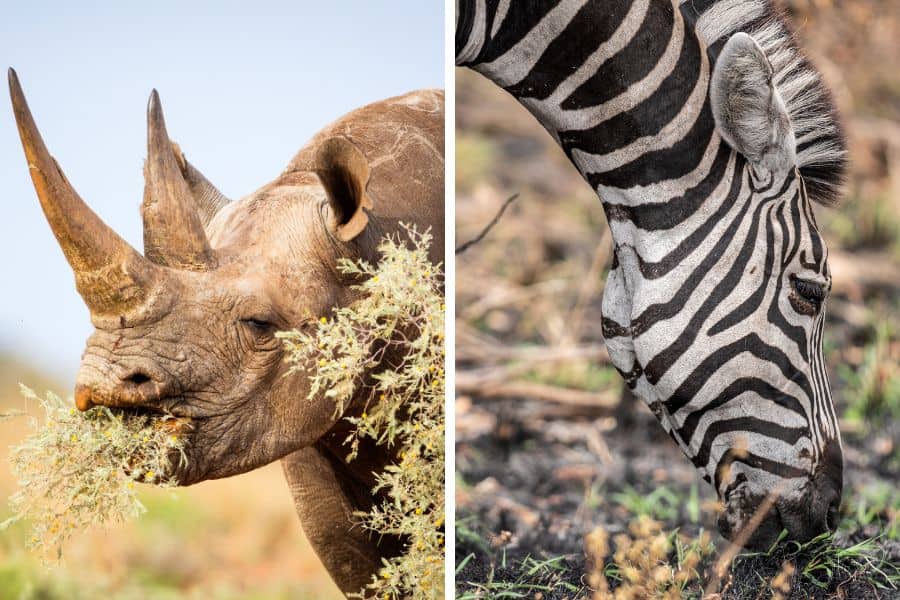Do gorillas eat meat?
These primates certainly look like predators, with their long canines and powerful physiques. Many other monkey and ape species are omnivorous, too – including humans!
Despite appearances – and many Hollywood portrayals – gorillas are mostly gentle giants. They don’t hunt and kill prey, unlike some of their ape relatives, preferring to graze on vegetation.
Are gorillas herbivores, then? Not exactly.
Most animals don’t fit neatly into a box, and gorillas are no exception. Africa’s largest ape isn’t 100% vegetarian, and gorillas may have the occasional animal-based meal.
Read on to find out about the gorilla diet, and other fun facts about this amazing great ape.
Gorilla Diet – Mostly Herbivorous
What do gorillas eat? While the different species (and subspecies) have distinct preferences, the gorilla diet is heavy on vegetation.
Mountain gorillas feast on foliage. Their diet is mostly made up of leaves, bark, shoots, and stems. Lowland gorillas eat many of the same foods but have a lot more fruit in their diet.
A gorilla’s day is divided into traveling, eating, and rest periods. All subspecies spend a lot of time roaming the forest and foraging, although lowland gorillas move further in their search for food.
Quality and quantity

People are often confused how large, muscular animals like gorillas maintain their physiques on a diet of foliage. It’s true that it’s not the most efficient way to fuel up, but gorillas make up for that with sheer volume.
Since the gorilla’s favourite foods are low in calories, they need to eat a lot to get enough energy. That means feeding takes up the bulk of their time. An adult male gorilla can eat up to 18 kg of food per day.
In absolute terms, they’re getting enough calories, protein, and other nutrients to maintain muscles that put bodybuilders to shame.
Occasional insectivores
Since they spend most of their time grazing on vegetation, you might be wondering: “when do gorillas eat meat?”
These great apes are opportunists and sometimes snag a few extra calories in the form of invertebrates. Lowland gorillas, in particular, will break apart ant or termite nests for an easy source of nutrients.
This is still a relatively tiny percentage of their overall diet.
Are insects “meat”?

The simple definition of meat is “animal flesh”, and insects/other invertebrates are animals. Technically, the answer to the question “do gorillas eat meat?” is obviously yes.
Some people use the term “meat” to describe only vertebrate flesh. Using this definition, the answer is a little less obvious. (More on that later.)
What do gorillas drink?
Most of the time, gorillas don’t drink anything. The vegetation they eat has a high water content, so they get all the hydration they need from their diet.
They will drink water occasionally, though.
Gorilla Digestive System
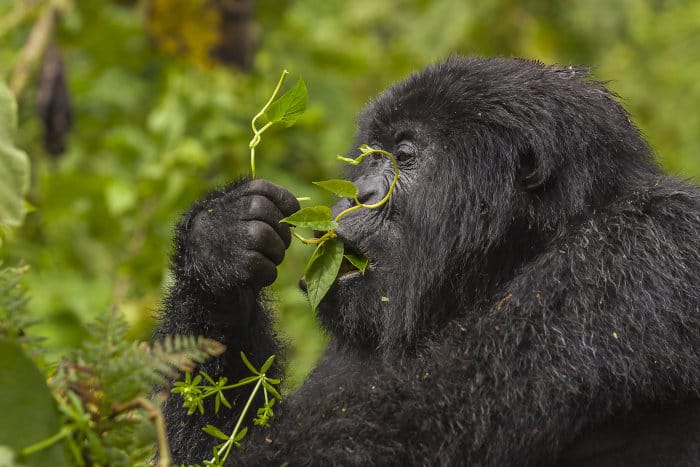
Gorillas and humans are genetically very similar, yet one major difference is the gorilla’s digestive system.
Gorillas, like many large herbivores including elephants and rhinos, are “hindgut digesters”. They have much longer intestines than carnivores or omnivores.
Gorillas’ diet is very high in fibre, which is hard to digest. This means they need much more time to digest their food and absorb enough nutrients. That’s where their long intestines come in handy.
Looking at the gorilla’s digestive system, it’s clear that they’ve evolved to eat a plant-based diet. Yet even so-called “herbivores” sometimes supplement this diet with meat.
Are Gorillas Herbivores or Omnivores?
Classifying creatures based on diet can be confusing. Most animals aren’t strictly herbivores or carnivores. Instead, they eat both animals and plant matter in varying amounts.
Do gorillas eat meat ever?
Yes – and to some people, that would make them omnivores. Yet “herbivores” like hippos occasionally snack on carrion, and deer have been filmed eating baby birds and snacking on human skeletons!
Equally, many obligate carnivores, which need to eat meat to survive, still consume some plant matter. In that sense, they’re both carnivores and omnivores.
Calling gorillas omnivores is technically correct, but it’s safe to say they’re mostly herbivores.
Their digestive system and eating habits align more with large grazing animals than “true” omnivores like baboons or raccoons, for example.
Do Gorillas Eat Monkeys?
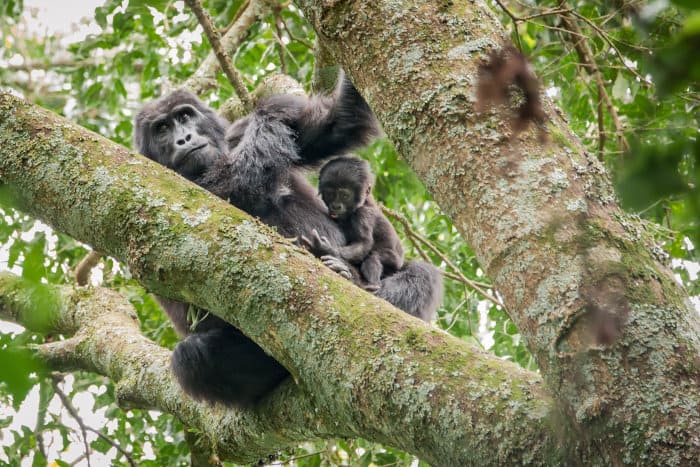
After placing gorillas firmly on the herbivorous side of the spectrum, this question sounds surprising. It doesn’t align with what scientists know about gorillas.
However, one 2010 study found mammal DNA in gorilla feces.
The study found monkey and duiker (a small antelope) DNA in western lowland gorilla scat, in Gabon.
This may sound like proof that gorillas eat meat from mammals, but there are other explanations.
One suggestion is that the gorillas ate ants which scavenged the monkey carcasses. Or maybe live monkeys and antelopes “might have just licked it, sniffed it, or peed on it”.
In the years since, gorillas still haven’t been observed hunting or scavenging other mammals, so there’s no proof they eat any animals larger than termites.
Meat-eating apes
While gorillas probably don’t eat monkeys, other African apes certainly do.
Chimpanzees are more omnivorous than their larger relatives and are known to form hunting parties to capture and eat monkeys.
Even bonobos, generally thought of as more “peaceful” apes, have been witnessed hunting and eating monkeys and duiker.
While meat doesn’t form a large part of most ape and monkeys’ diets, the majority of primates eat meat at least occasionally, and a handful are highly carnivorous.
Why don’t gorillas eat meat?
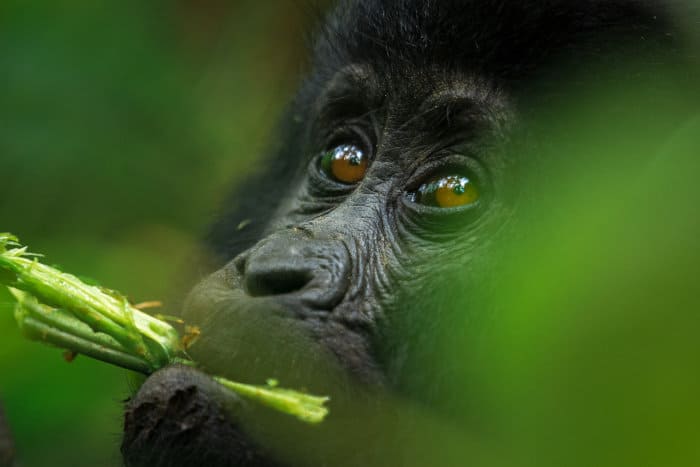
If the question is “can gorillas eat meat?” as opposed to “do gorillas eat meat?”, then the answer is probably yes. Their digestive system isn’t specialised for it, but plenty of herbivores snack on meat occasionally with no ill effects.
Several other apes can go long periods without eating meat but still see it as a rare treat when they get the opportunity to hunt.
Gorillas, on the other hand, seem content to stick to their regular diet. Anthropologist David Watts observed a duiker walk past a group of mountain gorillas, who ignored it.
Hunting fellow animals can be difficult or dangerous, so perhaps gorillas don’t think the reward is worth it. Maybe they prefer to conserve their energy; maybe they’re just thinking of their cholesterol.
Do gorillas eat bananas?
If you picture a monkey or ape eating, there’s a good chance it’s munching on a banana.
So, do gorillas eat bananas?
Yes and no.
Captive gorillas certainly find bananas “a-peeling” and often enjoy eating them. They’re not the healthiest meal, as today’s cultivated bananas are much more sugary than wild ones.
Wild gorillas don’t usually eat bananas, as they don’t grow naturally in the great ape’s habitat. However, when humans plant bananas nearby, gorillas might be tempted.
If you’re wondering how a gorilla peels a banana, the answer is “however they like”. There’s no single right way to do it.
Why Do Gorillas Have Large Canines?
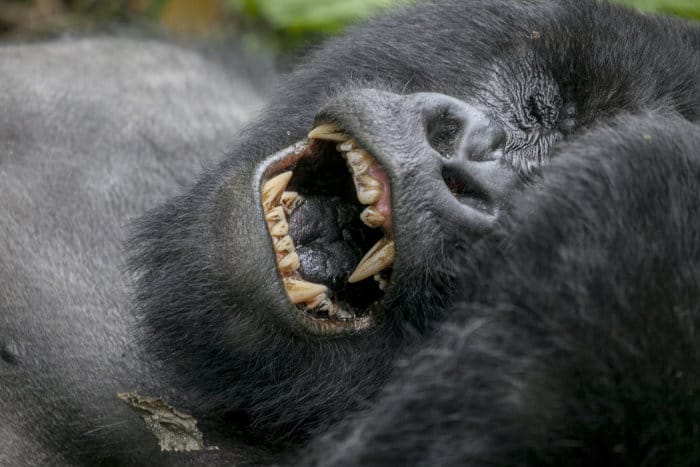
A silverback opening his mouth is a scary sight.
While gorillas have the same dental formula as humans, one obvious difference is the size of the canine teeth. Male gorillas’ canines can grow up to two inches in length (5 cm)!
Large, sharp canine teeth are a feature of apex predators, so it might seem surprising that the gentle jungle-dwellers are equally equipped. After all, they don’t need to kill prey or cut through meat.
Yet, female gorillas’ teeth aren’t so big, which gives a clue about why male gorillas have large canines.
Gorilla teeth – display and defence
Male gorillas compete for the affections of multiple females.
Only one silverback leads the “troop”, while other males either leave to find their own troop or become subordinate. The dominant male gets to mate with his harem, while unsuccessful males are out of luck.
Displaying a ferocious set of fangs is one way for a silverback to signal dominance, without usually resorting to violence.
While silverbacks don’t often have to use their canines, they’re not just for show. If the troop is under threat from a rival silverback or a predator such as a leopard, males can use their sharp canines to fight off the intruders.
Stripping flesh… from plants

Gorillas may not need to cut through meat, but they still need tough teeth to break down their starchy staples. Strong molars make short work of grinding up twigs and tree bark.
Do Gorillas Eat Meat? Barely
If you’re still wondering “do gorillas eat meat?”, don’t let it put you off going to see these awesome apes.
There’s no proof that the world’s largest primate preys on anything larger than small insects, and these voracious veggie-lovers would take a twig over a steak any day.
Despite their impressive size and strength, gorillas are some of the least aggressive apes. They don’t waste energy chasing after other animals and would much rather laze around munching on plants. Attacks on humans are extremely uncommon, and serious injury is even rarer.
Want to see gorillas in the wild?
Some of the most iconic destinations for mountain gorilla trekking include Bwindi in Uganda and Volcanoes National Park in Rwanda. Plan your tailor-made safari today and observe these amazing animals first-hand.


